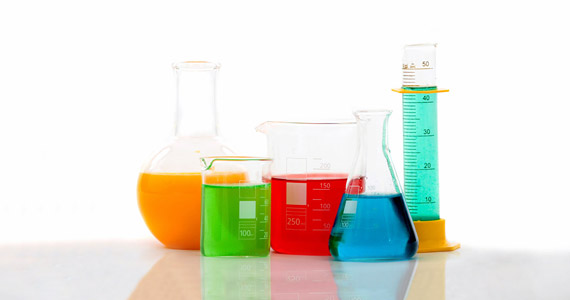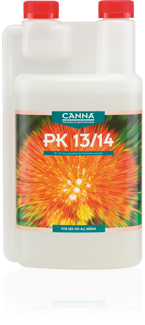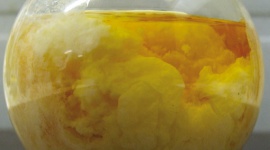Can PK supplements work miracles?
Plant growth

In nutritional terms, as a plant grows bigger, it will require larger quantities of nutritional elements, in absolute terms, in order to sustain itself. At the same time, although the uptake of certain elements remains constant, the plant’s need for other elements will grow or diminish at different stages in the plant’s life cycle.
Growers adjust the amount of nutrients provided by changing the ratios at which they are applied (for example, when they switch from growth nutrients to flowering nutrients), so that more (or less) of certain elements is provided. The amount of nitrogen required remains stable throughout the entire life cycle of the crop. If the grower applies more nitrogen during the growth phase, the amount given during the flowering phase will need to be reduced, so that the levels in the substrate remain constant.
By contrast, the amount of potassium needed increases as the plants grow and mature. This increase is achieved partly through the dosage applied, but the content of the nutrient formulation used during the flowering and fruiting phase is also different. The ratio of potassium to phosphorus in the nutrient formulation for the flowering phase needs to change in order for the plant’s changing requirements to be met.
CANNA formulations
CANNA formulations for the flowering phase contain plenty of potassium and phosphorus. However, there may also be periods during the growing phase when the plant needs more K and P. Simply increasing the dosage, but using the same formulation that was applied during the previous weeks, is not possible because that formulation also contains other elements such as nitrogen, magnesium, iron and other trace elements, which are already at their maximum levels. So the only other option is to add more P and K.

PK 13/14 ratio explained
PK 13/14: This means that there is 130g of phosphorus (P2O5) and 140g of potassium (K2O) per litre of nutrient formulation when dissolved in water. We approximate this to a 1:1 ratio of P to K. When we use this formulation, we apply almost as much extra phosphorous as potassium, in addition to what is contained in the Flores flowering formulation. But it is important to remember that Flores already contains a certain amount of P and K.
If we apply 1.5 ml PK 13/14 in addition to CANNA Flores in the 3rd generative phase, we are providing:
| 130 gr: 1000 ml | → 130 mg/ml x 1.5 ml | → 195 mg of P2O5 (phosphorus) on top of the Flores formulation |
| 140 gr | → 140 mg/ml x 1.5 ml | → 210 mg of K2O (potassium) on top of the Flores formulation |
These additional amounts end up in the substrate, gradually changing the ratio in the substrate, which still contains largely Flores, and producing the desired effect on the plant.
PK 20/21 ratio explained
PK 20/21 has the same ratio (1:1), but at a higher concentration. The recommended dosage is 0.5 ml / litre.

What does this mean in practice?
200mg of P2O5 and 210mg of K2O per ml. So if you only need to apply 0.5 ml, you should add 100 mg of extra phosphor and 105 mg extra potassium on top of the nutrient formulation for the flowering phase.
So you apply half as much phosphor (100 vs. 195) and potassium (105 vs. 210) as what you initially thought, compared with PK 13/14. This means it will take longer for any change in the substrate to happen.
So, any improved effect cannot be attributed to the PK 20/21 supplement, but rather to not adding half of it, if you compare this with PK 13/14.
PK 9/18 ratio explained
Some brands provide a different ratio of the two nutrients (1:2), with more potassium than phosphorus. The recommended dosage is 0.25 ml / litre.
What does this mean in practice?
90 mg of P2O5 and 180 mg of K2O in each ml. So if you only apply 0.25ml, you are providing 22.5 mg extra P2O5 and 45 mg extra K2O, on top of what is provided in the formulation for the flowering phase.
This means you are applying much less phosphor and less potassium as well, so not much will change in the substrate except that the ratio will be different. Again, any effect cannot be attributed to adding, but rather to NOT adding, if you compare this with PK 13/14.
The right PK supplement for the job
We hope that these 2 examples illustrate that in fact it is not applying more, or applying a different ratio that has a significant impact, but applying less.
This is exactly why CANNA recommends PK 13/14 as an additive. You should only use it if the plants have already developed enough flowers or fruits to need additional phosphor and potassium. And if that is the case, apply the supplement according to the supplier’s guidelines. In the end, the combination of a nutrient formula for the flowering phase and a PK supplement will result in the right ratio for the plant at that stage in its life cycle.
DO NOT MIX BRANDS, especially if they use a different PK ratios.





